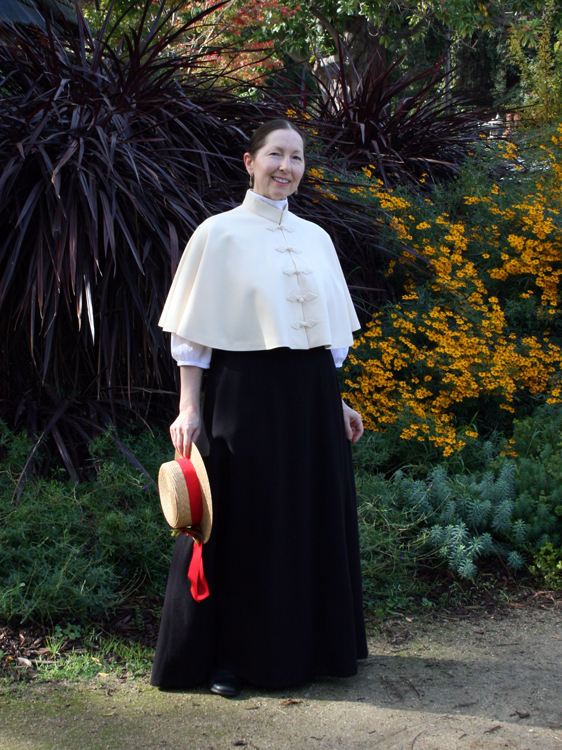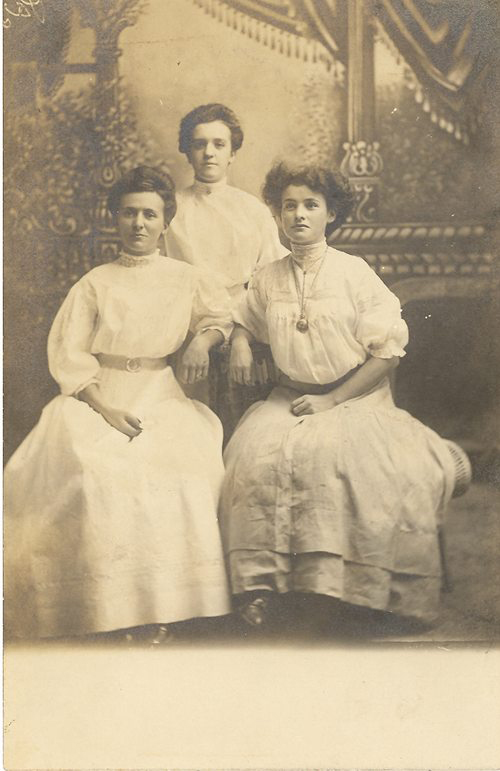

March 2010 – May 2011
Cream Wool Flannel, March – May 2010
An 1890s-1900s wool flannel cape made for a GBACG Bicycling in the Park event. The entire turn-of-the-century bicycle ensemble also includes a black wool walking skirt, Edwardian blouse and a boater.
Truly Victorian’s TV590 1890’s Cape was made up as a tailored garment. To adapt the pattern, I added a 1″ hem, 2″ extended facing, and a mandarin collar (from TV463 “French Vest bodice”). Because there were only 2 pattern pieces, all the stitching lines were thread-traced, which was a first for me. This really increased accuracy – especially since center front is cut on the bias. The cape is underlined in silk organza and lined in cream silk twill. Center front and neckline are taped, the hem is mitered, and I ease-basted the hem’s excess fabric to shrink it. The collar is interfaced with a layer of silk organza which is fused with knit interfacing. Collars are tricky and this was something of an experiment. But it stands up well enough and is still supple and comfy. Ultimately, tailoring is always a lot of work. But at least it’ll match everything in my closet!
It’s finished with 5 handmade cotton frogs that I found locally for $1 each. Frogs by themselves, however, do not keep the cape hanging straight. Instead, several hidden hooks are sewn to the facing, down the first few inches of center front.




Tartan Wool Flannel, March 2010 – May 2011
A tartan wool cape similar to the cream version.
I’d forgotten how difficult this plaid was to cut the first time around. I used it for Aaron’s holiday waistcoat and it was just giving me fits. So I ditched it (in the unfinished objects box). When I decided to give it another go, I cut off some facing and hem to correct for my original errors. Of course, center front still doesn’t mirror all the way down. The collar is interfaced with a woven, sew-in “firm support,” and the cape is lined in Bemberg rayon. The rest of the construction is the same.
1905 Blouse, March – April 2016
The blouse worn in these photos is a cotton dobby – sheer but heavily embroidered. It wasn’t going to work with a pattern that had a lot of gathering through the body, like Folkwear’s #205 blouse. I used the Laughing Moon guimpe pattern for the third time instead. It’s basically my eyelet blouse (worn with the bolero suit), with corrected armscye. I definitely wanted puffy sleeves, so Folkwear’s blouse sleeves were revised and added. It’s a relatively simple blouse. But the shape seems about right, per the two ladies on the left, in the photo below.
The fabric proved too bulky for french or flat-felled seams. So I tried something totally different. Each side of the seam allowance is finished separately into 3/16″ hand felled seams. The seam is flat and flexible, though at 3/8 inch, wider then you’d expect to see on a sheer blouse. The sleeves are gathered into 1/2″ bindings, using a wide stripe of the embroidery. The armscye bindings and collar lining are batiste. The blouse hem is overcast, a tip I picked up in Shaeffer’s Couture book. And I always splurge for the fancy buttons, despite the cost. In this case, they’re 3/8″ plain shell.



